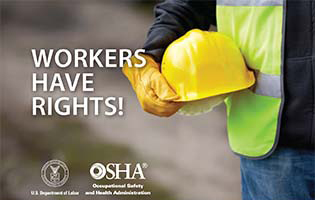Know Your Rights
Federal law entitles you to a safe workplace. Your employer must keep your workplace free of known health and safety hazards. You have the right to speak up about hazards without fear of retaliation. You also have the right to:
- Receive workplace safety and health training in a language you understand
- Work on machines that are safe
- Refuse to work in a situation in which you would be exposed to a hazard
- Receive required safety equipment, such as gloves or a harness and lifeline for falls
- Be protected from toxic chemicals
- Request an OSHA inspection, and speak to the inspector
- Report an injury or illness, and get copies of your medical records
- Review records of work-related injuries and illnesses
- See results of tests taken to find workplace hazards
When to File a Complaint
-
Safety and Health Complaint
If you believe working conditions are unsafe or unhealthful, you may file a confidential complaint with OSHA and ask for an inspection. If possible, tell your employer about your concerns.
-
Protection from Retaliation
It is illegal for an employer to fire, demote, transfer or otherwise retaliate against a worker who complains to OSHA and uses their legal rights. If you believe you have been retaliated against in any way, file a whistleblower complaint within 30 days of the alleged retaliation.
Contact OSHA
To discuss a health and safety issue at work, contact OSHA toll-free at 1-800-321-6742 (OSHA) or by email, or contact your nearest OSHA office. Your information will be kept confidential.

FREQUENTLY ASKED QUESTIONS
- What should I do if there is a dangerous situation at work?
- Am I covered by OSHA?
- What if I am injured at work?
- Can someone file a complaint for me?
- What happens after I file a complaint?
- What are my employers' responsibilities?
- What are my rights during an inspection?
- Does OSHA have other resources to help me?
- Does my employer have to provide Personal Protective Equipment (PPE) and who pays for it?
PSAs and VIDEOS
- Listen to public service announcements in multiple languages about your right to speak up about unsafe working conditions without fear of retaliation.
- Watch videos to learn more about your right to a safe and healthful workplace.
PUBLICATIONS
TOOLS & RESOURCES

Employer Injury and Illness Data

Common Hazard Citations
- See a list of the top 10 most frequently cited standards across all industries.
- Search for commonly cited workplace hazards with your employer's North American Industry Classification System (NAICS) code. Once you know your six-digit code, visit OSHA's Frequently Cited OSHA Standards page, enter your NAICS code and view the information for last year.

OSHA Law and Standards
The Occupational Safety and Health Act of 1970 created OSHA, which sets and enforces protective workplace safety and health standards. There are OSHA standards for construction, agriculture, maritime and general industry. Employers also must comply with the General Duty Clause of the OSH Act, which requires them to keep their workplaces free of serious recognized hazards.










